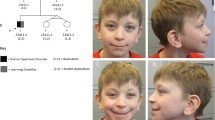Abstract
Rearrangements of chromosome 15q, including isodicentric 15 chromosomes and interstitial duplications and triplications, have been previously reported in association with autism spectrum disorders. We have identified two boys with exceptionally large der(15) chromosomes that are tricentric and contain four copies of the proximal long arm, including the Prader Willi/Angelman critical region, and leading to hexasomy of the involved segment. Biallelic inheritance of maternal alleles and methylation analysis indicate that the markers are maternally derived. Clinical assessment of the boys indicated severe cognitive impairment associated with marked delays in gross and fine motor skills. Social and language deficits were present in both, although the severity of the mental retardation precluded diagnosis of autism (both were considered to have pervasive developmental disorder-not otherwise specified). Neurologic manifestations included infantile spasms evolving into intractable early-onset myoclonic seizures, psychomotor regression, and profound diffuse hypotonia. These patients represent the most severe end of the spectrum of phenotypes associated with segmental aneuploidy for chromosome 15q11-q13.


Similar content being viewed by others
References
Caine A, Mason G, Daly HA, Ricketts SM (1993) An unusual tricentric X chromosome detected prenatally. Prenat Diagn 13:1061–1065
Eggermann K, Mau UA, Bujdoso G, Koltai E, Engels H, Schubert R, Eggermann T, Raff R, Schwanitz G (2002) Supernumerary marker chromosomes derived from chromosome 15: analysis of 32 new cases. Clin Genet 62:89–93
Glenn CC, Saitoh S, Jong MT, Filbrandt MM, Surti U, Driscoll DJ, Nicholls RD (1996) Gene structure, DNA methylation, and imprinted expression of the human SNRPN gene. Am J Hum Genet 58:335–346
Huang B, Bartley J (2003) Partial hexasomy of chromosome 15. Am J Med Genet 121A:277–280
Maggouta F, Roberts SE, Dennis NR, Veltman MW, Crolla JA (2003) A supernumerary marker chromosome 15 tetrasomic for the Prader-Willi/Angelman syndrome critical region in a patient with a severe phenotype. J Med Genet 40:e84
Mullen PD, Evans D, Forster J, Gottlieb NH, Kreuter M, Moon R, O’Rourke T, Strecher VJ (1995) Settings as an important dimension in health education/promotion policy, programs, and research. Health Educ Q 22:329–345
Nietzel A, Albrecht B, Starke H, Heller A, Gillessen-Kaesbach G, Claussen U, Liehr T (2003) Partial hexasomy 15pter→15q13 including SNRPN and D15S10: first molecular cytogenetically proven case report. J Med Genet 40:e28
Qumsiyeh MB, Rafi SK, Sarri C, Grigoriadou M, Gyftodimou J, Pandelia E, Laskari H, Petersen MB (2003) Double supernumerary isodicentric chromosomes derived from 15 resulting in partial hexasomy. Am J Med Genet 116A:356–359
Schreck RR, Breg WR, Erlanger BF, Miller OJ (1977) Preferential derivation of abnormal human G-group-like chromosomes from chromosome 15. Hum Genet 36:1–12
Schwartz S, Depinet T (1996) Studies of “acentric” and “dicentric” marker chromosomes: implications for the definition of the functional centromere. Am J Hum Genet 59:A14
Schwartz S, Aughton DJ, Gunay-Aygun M, Sekhon GS, Depinet TW (1998) Studies of “tricentric” chromosomes: centromere activity and mechanism of formation. Am J Hum Genet 63:A40
Thomas NS, Roberts SE, Browne CE (2003) Estimate of the prevalence of chromosome 15q11-q13 duplications. Am J Med Genet 120A:596–598
Ungaro P, Christian SL, Fantes JA, Mutirangura A, Black S, Reynolds J, Malcolm S, Dobyns WB, Ledbetter DH (2001) Molecular characterisation of four cases of intrachromosomal triplication of chromosome 15q11-q14. J Med Genet 38:26–34
Acknowledgements
The authors are grateful to the patients and their families for participating in this study. We also thank Donna Bennett of the IDEAS support group for her support of our work. We thank David Ledbetter and Judy Fantes for genomic clones and mapping information, Mario Rochhi for the pCM15 clone, and Rhona Schreck, Alma Lopez-Singh, and Laura Espana for their invaluable assistance. This work was supported by the NIH Collaborative Programs in Autism Research (PO1 HD35470), the M.I.N.D. Institute, the F & F Foundation, and Nemours Biomedical Research.
Author information
Authors and Affiliations
Corresponding author
Rights and permissions
About this article
Cite this article
Mann, S.M., Wang, N.J., Liu, D.H. et al. Supernumerary tricentric derivative chromosome 15 in two boys with intractable epilepsy: another mechanism for partial hexasomy. Hum Genet 115, 104–111 (2004). https://doi.org/10.1007/s00439-004-1127-5
Received:
Accepted:
Published:
Issue Date:
DOI: https://doi.org/10.1007/s00439-004-1127-5




